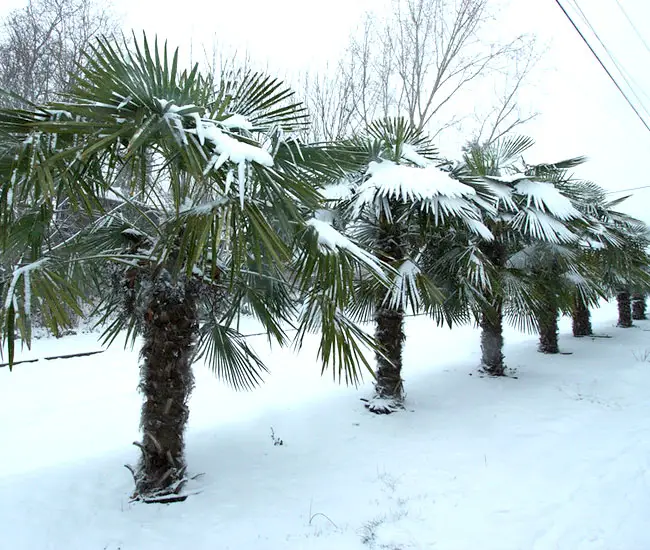
While cold-hardy palms can endure freezing temperatures, tropical palms may suffer from cold damage. Typically, palm tree owners in warm climates don’t worry about cold weather.
However, with the unpredictable winters of recent years, freezing temperatures have become less of a surprise.
Cold weather can impact palm trees in various ways. It slows down root activity and the growth rate of the palm.
Freezes or frosts can harm the palm tissue in the trunk, potentially limiting its ability to supply leaves with adequate water.
Unfortunately, palm trees can’t regenerate conducting tissue, and they may eventually succumb. If the bud, also known as the “palm heart,” sustains damage, the palm won’t survive.
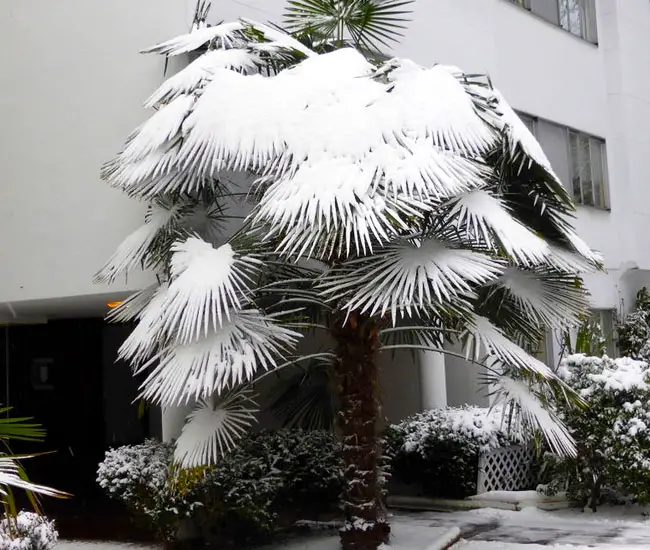
How Cold Is Too Cold For Palm Trees
Palm species differ widely in their sensitivity to cold. Some palm types can endure cold temperatures down to 10-15°F for brief periods, while others suffer damage when temperatures dip below 45°F.
The cold tolerance of a palm also depends on summer care, plant age, and the time it was established. To determine the lowest temperature your palm can endure, start by checking the cold tolerance specific to its species.
You can find this information in my palm tree catalog under the ‘Cold Hardiness’ section within the palm profile.
Keep in mind that by providing winter protection, you can extend a palm’s tolerance by one-half or even a full USDA zone.
10 Ways To Protect Your Palm Trees From Winter Freeze, Cold, or Frost
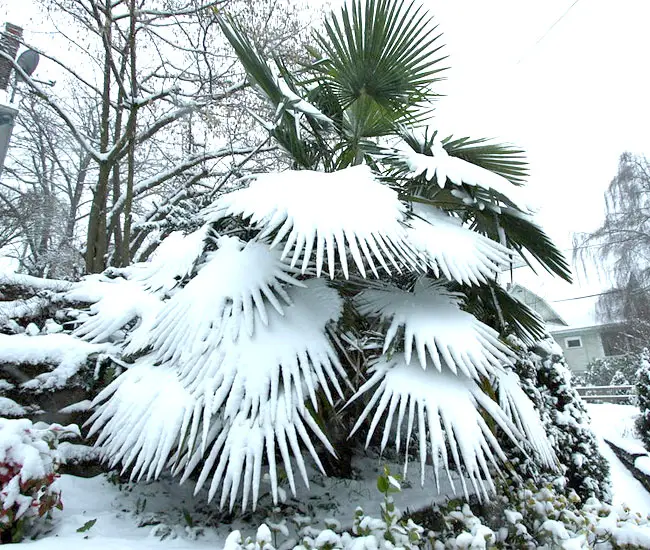
Before we jump into the various ways to protect your palm trees from winter’s chill, it’s important to note that a little cold weather can actually be good for them.
It promotes dormancy and toughens them up to handle the cold better. So, don’t start winterizing your palms too soon.
Unless there’s a sudden and significant drop in temperature, let your palms gradually acclimate to the cooler conditions.
The main goal here is to shield the palm’s most crucial part, the bud, and reduce potential harm to the leaves and stems in case an unexpected freeze occurs.
Thankfully, there are plenty of things you can do to prepare and protect your palm tree during winter. Some are super easy, while others require a bit more effort. And you’ll be pleased to know that even the simplest steps can bump up your garden’s USDA zone rating by half or even a full zone.
Thankfully, there are plenty of things you can do to prepare and protect your palm tree during winter. Some are super easy, while others require a bit more effort.
1. Palm Fertilization
Palm trees with nutrient-starved tissues aren’t as cold-hardy. So, it’s important to make sure your palm gets the right amount of fertilizer in the months leading up to the cold season.
According to recent research from the University of Florida, giving your palm a good dose of fertilizer actually toughens it up for the cold. When to fertilize depends on where you live and how long your growing season is.
For areas with chilly winters, avoid overloading your palm with fertilizer late in the growing season, since the palms will continue to grow into the early winter. That will delay the dormancy and make them more susceptible to cold damage.
I’d recommend using a top-notch slow-release fertilizer with a balanced ratio of Nitrogen (N) and Potassium (K). You can tell the ratio by looking at the three numbers on the label (NPK), like 15-5-15 or 20-15-15.
Stay away from lawn fertilizers with something like 27-2-2 on the label, as they encourage leafy growth instead of strong roots and beautiful blooms. You can check out my top 10 recommended fertilizers in my palm tree fertilization post.
2. Palm Heavy Mulching
Heavy mulching is the most effective way to minimize leaf damage and maximizing tree survival.
You are probably already applying mulch all year round, but during winter mulch your palm more heavily. Adding 4-6 inches of mulch will protect ground from freezing deeply, thus protecting roots and lower trunk of the tree.
Since a lot of cold tolerant palms have their buds underground, mulch will keep the temperatures relatively constant protecting it from cold damage caused by rapid temperature fluctuations.
Also, unfrozen roots will be able to replenish the moister lost during winter transpiration. I recommend using organic mulch like course wood chips, maple or oak leaves, wheat straw or pine straw because they don’t compact too much over winter and moderate soil temperatures, suppress weeds, conserves moisture, and add nutrients to the soil as they decompose.
Another benefit of using whole deciduous tree leaves with the mulch, is that they release considerable amount of heat while decomposing. To keep the mulch from blowing away you can use a wire netting enclosure. Put the mulch 1-2 ft away from the trunk of a small palm and about 3-4 ft away from a large tree.
You should leave the mulch until your area is done with the frost and then gradually remove it over a period of a 3-4 days. Removing it slowly will provide your palm with more time to get used to increasingly stronger sunlight and also provide some protection against a late frost.
3. Heavy Watering
While mulching keeps the roots from freezing, it doesn’t solve the challenge of water uptake, which significantly drops when temperatures dip below 40°F (5°C). Winter’s cold winds, combined with afternoon sun exposure, can lead to winterburn and leaf loss for your palm tree.
To ensure your palm has access to ample water, it’s essential to start the winter season with well-watered soil and maintain consistent moisture throughout the cold months.
Before a cold snap arrives, water the soil around your palm generously. Lukewarm water is preferable over cold water because it helps warm up the ground, facilitating water absorption by the palm.
Remember, moist soil loses heat less rapidly than dry soil, which benefits your palm before a sudden cold spell comes.
4. Antitranspirant Spray
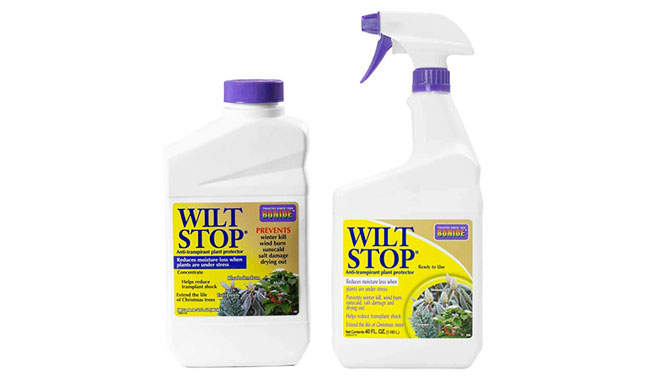
Another method to minimize water loss from the leaves is by using an antitranspirant spray. This spray creates a soft, clear, flexible film on the plant’s foliage, retaining moisture and reducing water loss during stressful conditions. I personally recommend using ‘Wilt Stop’ by Bonide for this purpose.
I apply it for winter protection or to reduce transplant shock when moving a palm during the growing season.
This product shields plants from drought, windburn, sunscald, winter damage, transplant shock, and salt damage while allowing them to grow naturally.
5. Copper Fungicide Spray
Palm trees stressed by cold temperatures can become susceptible to bacterial and fungal infections. While low levels of bacteria on healthy palm tissue are harmless, they can become problematic once the palm has been damaged by cold weather.
That’s why it’s a good practice to spray the tree with a fungicidal copper solution before freezing temperatures set in. This helps reduce the bacterial population to the lowest possible levels.
A few days before the anticipated cold weather arrives, spray the stem and foliage with a broad-spectrum fungicide/bactericide like ‘Liquid Copper Fungicide‘ by Southern Ag. This product has a unique formula effective against both bacteria and fungi.
Applying this spray to open-crowned palms is important because water collected in their crowns may freeze and thaw, potentially causing tissue damage and creating ideal conditions for bacterial and fungal growth.
6. Warm Cover
When the cold days arrive, it’s a smart move to provide some cover for your palm. For smaller palm trees, you can use a weighted-down box or a blanket.
On sunny days, consider partially opening the box to prevent the air inside from getting too hot, even if the outside temperatures are freezing. However, don’t keep the tree under cover for more than three consecutive days.
After this period, make sure to uncover your palm during the day to allow it to receive some essential light.
For larger palms, opt for a blanket, burlap, or similar warm material. Avoid materials that absorb water, like cotton, as they can trap moisture and lead to trunk rot.
When draping the cover over the tree, ensure it hangs loosely to trap warm air rising from the soil underneath. This will help maintain the palm at a temperature 4-5 degrees warmer than the surrounding air.
Remember to remove all covers once the weather warms up, and avoid using plastic coverings, as they can trap moisture and cause additional damage.
7. Palm Trunk and Foliage Wrapping
Wrapping the trunk and foliage is an effective palm winterization method, especially for palms with central trunks. Use a material that doesn’t absorb moisture, such as a synthetic blanket, burlap, or landscape fabric.
Before wrapping, treat the area with a fungicide/bactericide spray like Liquid Copper Fungicide by Southern Ag.
Start by wrapping the material around the trunk and secure it with duct tape. Continue wrapping upward, gathering the leaves closer together into a bunch.
Wrap as high as the stiffness of the leaves will allow, without worrying about damaging the foliage. Smaller palm trees can be completely covered with the foliage mass.
In extreme weather, you can drape a cover over the open foliage of larger palms, removing it once the cold has passed.
Even a single layer of wrapping can add 2°-3°F (1-2°C) of protection, and multiple layers of synthetic blanket can provide a full USDA zone of protection, keeping temperatures under the wrap 6°-8°F (4°-5°C) warmer than outside.
While some gardeners use bubble wrap, it may cause condensation issues, so it’s not recommended. You can leave the wrap on until early spring.
Pro Tip: To minimize the fungal and bacterial issues, place sticks around the trunk before wrapping to ensure the wrap doesn’t touch the trunk directly.
8. Heater and Light Bulbs
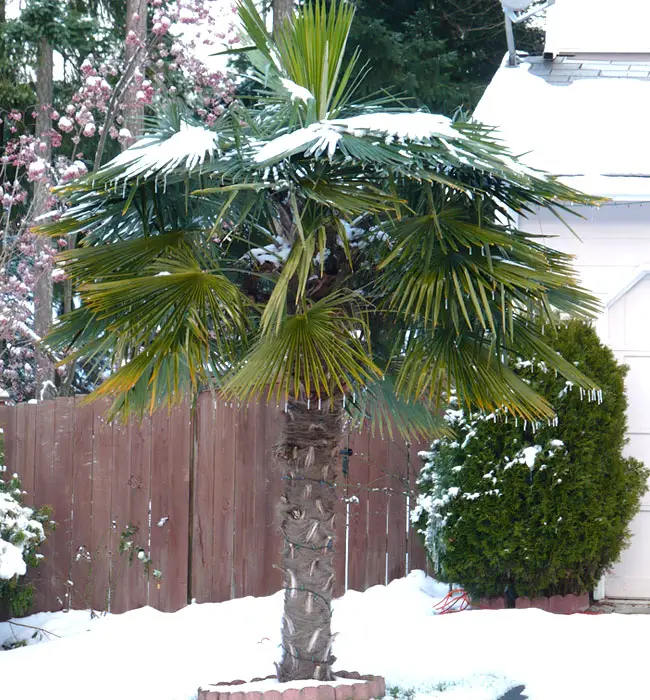
To add warmth to your palm, consider using a small propane heater positioned near the tree and use a fan to direct the warm air toward it. Ensure the heater is placed at a safe distance from the palm to avoid overheating or causing burns.
Alternatively, a highly effective method is to winterize your palm tree with Christmas lights. Simply wrap them around the trunk a bit denser than usual.
During cold winter nights without wind, these lights can raise the temperature by 2°-3°F (1-2°C). However, in windy conditions, the heat dissipates too quickly to provide substantial warmth.
If you place holiday lights beneath a loose landscape fabric, you can easily add another 10°-15°F (6°-9°C) of warmth. While this may seem like an ideal solution, be cautious as it might dry out the tender leaves.
Pro Tip: If you are relying on snow as your cover, be mindful of the light bulbs. They can melt the snow around the palm, leaving it fully exposed to freezing air and cold winds.
9. Heat Cables
Another popular palm winterization technique involves using low-wattage heat cables. Typically used to wrap water pipes and prevent freeze damage, heat cables can be found in hardware stores. Like holiday lights, they can be wrapped around the trunk and foliage of the palm.
What’s great about heat cables is their exceptional safety and reliability. Most of them come equipped with a built-in thermostat that automatically activates the heating cable when the temperature drops below 40°F (4°C) and turns it off when it rises above 55°F (13°C).
Some gardeners also use heating cables to wrap around the root ball when planting a palm. This allows them to activate it during a cold winter, providing heat to the root zone and preventing freezing of the roots.
Additionally, it warms up the water, providing supplementary heating to the above-ground plant tissues as water moves up the root system.
10. Temporary Greenhouse
If you have a lot of time and energy, you can build a temporary greenhouse around your palm. Adding a supplementary heat to the greenhouse will add two or even more full USDA zones to your garden.
This is the most involved method that will allow you to grow palm trees almost anywhere. Of course, the greenhouse structure has to be strong enough to withstand strong winds, freezing rain and heavy snow.
Built a wooden frame above the tree and cover it with a double plastic sheet nailing it to the frame. Wet snow is very heavy, so make sure to built a slanted roof.
Final Thoughts
When I anticipate cold weather on the horizon, my go-to approach typically involves heavy mulching, thoroughly saturating the root area with water, spraying the tree with a broad-spectrum fungicide/bactericide, and adorning it with Christmas lights.
If the cold spell is expected to persist for several days, I opt for antitranspirant spray in addition to wrapping beneath the Christmas lights.
This usually suffices for my needs, as I live in a warm climate where more advanced winterization techniques are generally unnecessary. I hope my tips will help you prepare your palm trees for cold weather.
Related articles:
–Top 20 Palm Trees That Can Survive Freezing Weather
–10 Expert Tips On Growing Palm Trees In Cold Climates
–Secret to Growing Cold Hardy Palm Trees
–Importance of Microclimate When Choosing Cold Hardy Palms
–5 Steps To Saving Freeze Damaged Palm Tree

We’ve had A LOT of rain lately. If all of my Palm fronds fell out of the tree, but there is still green in places around the trunk, is it dead? Every Palm frond fell out, like they just lifted right out of the top like they were never attached in the first place. No Palm fronds at all left on the tree.
Hello, I tried to register so I could ask a question but I couldnt make it take the information. I have a 6 ft high Lipstick Palm that I have in my back yard in South Florida.
It seems to be healthy, I water it constanly and fertilize often. The leaves seam to get week in the middle on some of the frowns and bend. Any idea what this plant may need? Its planted mostly in the shade. Thank You
Can I have palm tree because the temperature gets -15 in winter.
We just planted 3. 6 ft trees , 2windmill an 1 pindo with, 37 degrees coming and 15mph winds was thinking of covering with prefforated plastic and putting a heat lamp underneath as well we’ve already covered up the trunk , I basically I’m going to build a temporary green house , thoughts
??